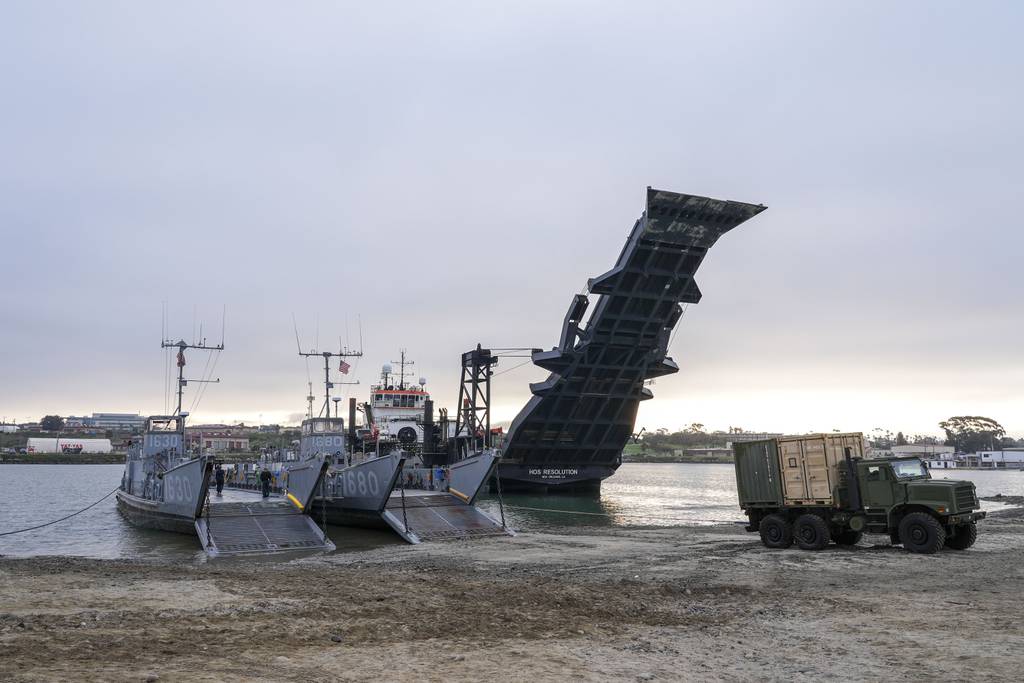
A key vessel Marines need to move around in a potential island shootout with China is two years behind schedule, could cost nearly triple its original estimate and the short-term fix isn’t cheap.
The Navy’s landing ship medium program expects to award its design and construction contract in fiscal year 2025, two years later than originally planned, according to the Government Accountability Office’s Annual Weapons Systems Assessment, released Monday.
The concept, formerly called the light amphibious warship, was launched in 2020 to procure 35 such stern landing vessels.
The ship would hew closely to commercial designs to lower its signature and provide the recently formed Marine littoral regiments with options for maneuvering in areas close to shore and within island chains, especially in the Pacific.
The current ship being used for testing is the stern landing vessel, a modified commercial watercraft that allows users to offload and onload directly from the beach.
“It is a shore-to-shore logistics connect to get heavy things that we can’t put on airplanes or don’t want to have a big ship coming in to bring, get it from Point A to Point B to move; maneuver it from Point B to a more advantageous position at Point C; and then sustain that position,” Assistant Commandant Gen. Christopher Mahoney said in March.
Original design features for the landing ship medium concept include:
- A length of 200 to 400 feet.
- A draft, or depth of the vessel beneath the waterline, of 12 feet.
- A crew of about 70 sailors.
- The capacity for carrying 50 Marines and 648 short tons of equipment.
- 8,000 square feet of deck cargo space
- Transit speed of 14 knots and a cruising range of 3,500 nautical miles.
- Roll-on/roll-off beaching capability for beaches with a 1:40 grade.
- A helicopter landing pad.
- Two 30 mm guns and six .50-caliber guns for self-defense.
- A 20-year service life.
Source: Congressional Research Services
The first of three planned regiments became operational in 2023. The Navy is developing a bridging strategy, according to the report. Marine Corps Times has reported on ongoing experimentation with commercial vessels modified to meet the service’s landing needs throughout the past two years.
But those solutions require “significant modifications,” according to the report, costing upward of $115 million per modified vessel.
A 2020 report by Congressional Research Services that was updated in April noted that Congress could consider adapting the existing fleet of Army logistics support vessels for at least some of the Marines’ requirements.
The Army has more than 100 such vessels in its fleet, according to that report. Dozens of those vessels have similar capabilities to the landing ships the Corps is seeking.
At the time the Army had sought to divest some of its watercraft fleet. But since then, the service has shifted its logistics needs to the Pacific and now wants to expand the fleet, Defense News reported.
Under the current timeline, the Navy expects to award the construction contract for the ships in March 2025 and have the first ship delivered by January 2029. On that schedule, the Navy expects to conclude operational testing by July 2030 and hit initial capability by December 2034, according to the Government Accountability Office report.
Another report released in April shows a much higher overall cost for the program than officials originally planned.
The Congressional Budget Office estimated the initial 18-ship program could cost between $6.2 billion and $7.8 billion in 2024 inflation-adjusted dollars, Marine Corps Times’ sister publication Defense News reported in April.
That translates to $340 million to $430 million per hull.
That’s three times more than the original estimate of $2.6 billion for the program ― or $150 million per ship.
If the Navy gets the green light to buy the full fleet of 35 landing ships, as the Marine Corps has requested, the program will cost between $11.9 billion and $15 billion, according to the Congressional Budget Office report.
Todd South has written about crime, courts, government and the military for multiple publications since 2004 and was named a 2014 Pulitzer finalist for a co-written project on witness intimidation. Todd is a Marine veteran of the Iraq War.
- SEO Powered Content & PR Distribution. Get Amplified Today.
- PlatoData.Network Vertical Generative Ai. Empower Yourself. Access Here.
- PlatoAiStream. Web3 Intelligence. Knowledge Amplified. Access Here.
- PlatoESG. Carbon, CleanTech, Energy, Environment, Solar, Waste Management. Access Here.
- PlatoHealth. Biotech and Clinical Trials Intelligence. Access Here.
- Source: https://www.defensenews.com/news/your-marine-corps/2024/06/18/marines-corps-landing-ship-taking-longer-costing-more-than-planned/



